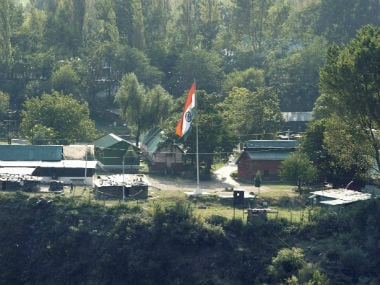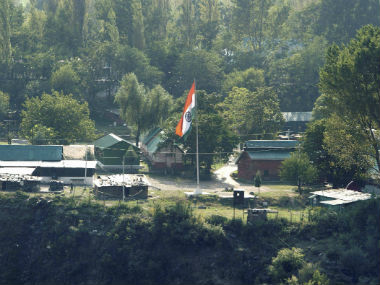The unconfirmed report of a recommendation of the Central government to the Indian Army to compulsorily retire officers, under whose watch terrorist intrusions into garrisons have occurred in the recent past is an idea that is likely to generate much debate, and rightly so. It is also reported that the government is not looking towards any disciplinary proceedings for dismissal but rather the officers being asked to leave the service honourably with their pension and other dues intact. Under existing rules, such a direction holds no legality but that isn’t the issue. It is the moral angle which is far more important which necessitates the complete understanding of what military responsibility in conflict conditions really entails. For all practical purposes, Jammu and Kashmir is considered a theatre of conflict under hybrid conditions.[caption id=“attachment_3011514” align=“alignleft” width=“380”]  The army camp in Uri where the attack happened in September 2016. PTI[/caption] The context we are referring to is of the three terror suicide attacks at the garrisons at Uri (18 September 2016), Nagrota (29 November 2016) and Sunjuwan (10 February 2018), in Jammu and Kashmir leading to large scale soldier casualties. This is not the first time that issues of military failure are under focus. These have happened in 1965, 1971 (to a lesser extent) and 1999 (Kargil) too; regarding 1962 less said the better. All these were conventional military operations where the optimisation of resources and lack of tactical effectiveness were investigated in a few cases. In 1965 we witnessed a couple of demotions to lower rank. Since 1999 was an initial failure the euphoria of subsequent success overshadowed the earlier negativity although careers of many officers were sealed permanently. The issue which is often debated in Indian military circles about the initial failures at Kargil is the level at which the buck needs to stop and responsibility be ascribed. In Kargil, both the Corps and Army Commander were decorated with high awards but the Division Commander and his subordinates under whose watch Kargil intrusions occurred had their careers sealed. Some were investigated and disciplinary action taken through the right procedure. Interestingly in 1987 when the Indian Army suffered high casualties for the blustering way it went advancing into Jaffna no one was investigated but through the 30 months that the Indian Peace Keeping Force stayed in Sri Lanka many a commander met his career doom. Instances, where 20-30 men were killed due to operational laxity, did result in sealed careers for many extremely competent officers. Even the irregular operations by terrorists in Jammu and Kashmir conducted in sync with Kargil in 1999 resulted in the first intrusions into military and police camps in Jammu and Kashmir. No one was asked to go home for the failure at Chak Nutnus, Beerwah (two subedar majors killed by intrusions in less than a year) or Khanabal. From then till 2005 countless such intrusions occurred in police camps all over Jammu and Kashmir. It was very clear that the ground and equipment state just did not cater for even basic optimisation. Ramshackle defence stores, inadequate perimeter security material and resources and absence of lighting and surveillance equipment made these posts and establishments sitting ducks under the circumstances. The Inspector General CRPF in Srinagar in 2000 summed up the operational environment post the unsuccessful terror attack at Srinagar airport by a LeT suicide squad, by stating that when the adversary comes wearing his own funeral shroud then it becomes near impossible to stop him. One can play devil’s advocate here and state that there were also units which were so alert that anyone observing them would not even dare to attempt an intrusion in their camps. For the military profession where resources lack they are made up by better training, improvisation and will to be effective. During the Burma Campaign when malaria threatened to become a bigger enemy than the Japanese, Field Marshal Slim ordered action against Commanding Officers whose anti-malaria precautions were ineffective in avoiding malaria casualties. Incidents of malaria came down quite drastically thereafter. The Indian Army like most militaries around the world believes that being ‘runners up’ in an operational environment can never be justified. General Ved Malik during Kargil operations 1999 famously quipped that the Indian Army would fight with what it had; it did and won the war. On the other hand, it could have sat back and said intimation of deficiencies was made to the government and since these were never made up it was not possible to fight the adversary and win. Military ethos cannot be viewed in binaries; that we are prepared or not prepared, equipped or not equipped, trained or not trained, is never the question. It’s a truism that a hundred percent capability will never exist. Yet the military optimises and maximises with what it has. Many in the armed forces will disagree and their point of view is important too. Pursuing such an ethos of functioning will inevitably lead to weak-kneed leadership willing to sacrifice lives that which cannot stand up to the political leadership and bureaucracy and be counted when budgets are unrealistic, procurement procedures are made lengthy and difficult and there exist discrepancies galore. An excellent practical example is that of the Uri garrison. Just six kilometres from the Line-of-Control and responsible for a strategically significant salient, the Uri garrison has one of those challenges which face many a military commander in his career. How much of his resources to deploy at the LoC for the main task and how much at the rear to ensure the security of vulnerable assets. Given this situation for many years, commanders of this garrison had demanded a security wall so as to optimise garrison security with minimum resources and thus deploy the maximum strength ahead where operational effectiveness is needed. Somehow the wall had not materialised even by 2016. In that year the commander took the risk as we all did in previous years, deploying minimum at the rear and maximum in front but failed to stop the attack which took place on his garrison. It was just one of those things which could have happened even in the time of his very illustrious predecessors. Military commanders are supposed to bring their luck with them to their command but can this adage be carried to a ridiculous extent. None of the above arguments will clarify anything because the issue under discussion cannot have black, white or binary decisions. The rank and file will have no problem in fixing accountability in failure if the same is also accepted by those who were indirectly responsible for the capability development of the force. People wish to know how many times such issues were brought to the notice of Parliament and what stance was taken by the government in its replies. When the Parliamentary Standing Committee on Defence takes note of deficiencies in capability, points them out and finds no response to it, someone has to bear responsibility for it. What the government is attempting is, however, the right thing; fixing accountability is important but the way it is to be done is the million dollar question. Somewhere it is obviously not gelling when the only people held responsible for military failure are military commanders. Hybrid conflict is far more complex and the involvement of the State besides the military is extensive making responsibility a collective affair more than ever before. Lastly, the military functions in nebulous circumstances where failure and success is a thin line. There are far too many intangibles in the profession. Judging the role of these in situations of apparent failure needs to be circumstantial and not related to pre-judged notions of success or otherwise. None but the forces themselves can comprehend these. It is, therefore, best to leave self-correction measures to the armed forces themselves who are known to be fair in such a domain. Alternatively, an accountability code related to the military be drawn up which should include the accountability of all other departments which contribute to the efforts of the armed forces. A debate as important as this one cannot be brushed away with one analysis. It must be developed through many more perceptions and thoughts to finally create a system which is both fair and effective and perceived to be so by one and all.
Hybrid conflict is far more complex and the involvement of the state besides the military is extensive making responsibility a collective affair more than ever before.
Advertisement
End of Article


)

)
)
)
)
)
)
)
)



